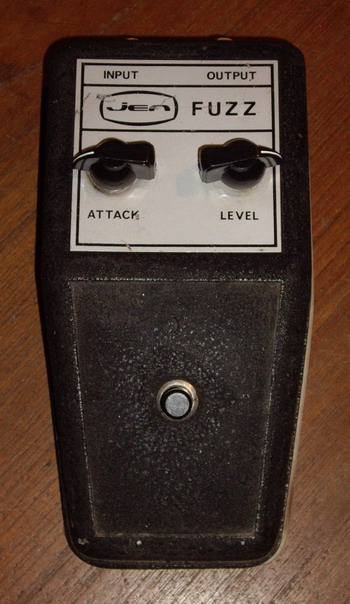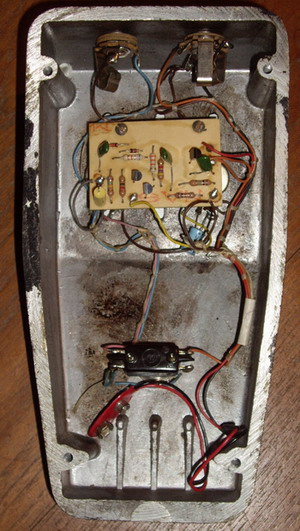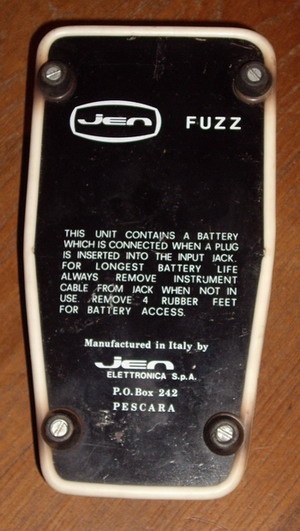



60's JEN TONE BENDER
Made in Italy by the Jen Company, based on the MK I.V two transistor Tone Bender circuit, very similar to the Fuzz Face sound. This is probably the most well known version of the Tone Bender. The circuit is nearly identical to the Vox Distortion Booster and the Tone Bender MK1.V
•1967 - Creation of JEN Elettronics. Thomas Organ was making the first Cry Baby Wah Wah pedals in California, but Joe Benaron, president of Thomas Organ, wanted to move production to Italy to reduce costs. Joe approached the manufacturing company Eko in Italy about making the Wah. Eko declined, but Eko's manufacturing manager, Ennio Uncini, wanted to do it. Ennio and Joe then formed their own company in 1967 called JEN (named from the J in Joe and EN from Ennio). Ennio supervised operations in Italy, where Jen handled the Cry Baby Wah production for a while in 1968, as well as making the Vox Wah Wah's and other Vox pedals. Thomas Organ distributed the pedals in the USA, and JEI distributed them for the European markets. Jen later marketed a line of pedals under their own brand beginning in 1968.
•1967 November or earlier - Vox Tone Bender on market. This is the Italian made Tone Bender, manufactured by JEN in Pescara, Italy. Gary Hurst has stated (in Guitarre 2003) that the first Italian Tone Benders were actually made by Eko, where the AC-30 was made, then moved to Jen. It was sold around the world, and is usually the unit most people think of when they hear the name Tone Bender. The Italian Vox TB replaced the briefly made Vox TB MKII manufactured by Sola Sound in 1966. The most likely reason for JMI to use Italian production instead of continuing to use Sola Sound would have been that the mass production capabilities were far larger at JEN, and the Italian's charged less than Sola Sound. Vox products were sold world wide, so capacity would have been the primary factor. Vox had used multiple manufacturers for Organs, Wah Wah pedals, and guitars in the past, to meet demand for product, so this was common. A Vox Tone Bender has been seen with an inspection tag for Vox V828 #5035, dated "13 November 1967".
Early Wah's were made in California, but Joe Benaron, president of Thomas Organ, wanted to move production to Italy to reduce costs. Joe approached the manufacturing company Eko in Italy about making the Wah. Eko declined, but Eko's manufacturing manager, Ennio Uncini, wanted to do it. Ennio and Joe then formed their own company in 1967 called JEN (named from the J in Joe and EN from Ennio). Ennio supervised operations in Italy, where Jen handled the Cry Baby Wah production for a while in 1968, as well as making the Vox Wah Wah's and other Vox pedals like the Vox ToneBender. Thomas Organ distributed the pedals in the USA, and Jennings Electronics Industries (run by Tom Jennings, owner of the Jennings Organ Company and former head of Jennings Musical Industries) distributed them for the European markets. Jen then began to market a line of pedals under their own brand in 1968. Many were sold in the US under Gretsch and Sam Ash brands. Thomas Organ patented the Wah circuit design, but by the time the patent was granted there were already dozens of copies of the pedal on the market. It was decided enforcing the patent was too expensive, so no attempt was made to stop the knockoffs. Jen then got into the market of cloning other company's pedals themselves.
Around 1973 Jen created a series of four brightly colored effect pedals in die cast enclosures, each with slider controls rather than knobs, and each using reworked circuits based on existing designs from other companies. One of these was the Jumbo Fuzz, which was also rebranded as the Dallas Arbiter Jumbo Fuzz in Europe, and the Sam Ash Jumbo Fuzz/Sam Ash Fuzzola II in the America. The enclosure used was simiar to Jen's black powder coated ToneBender case, but with recessed areas on the top for the color label plates to be applied. The same enclosure was also used by Jen for some Vox ToneBender production and the Unicord Fuzz. A key identifying and dating feature to the enclosure was the white rubber skirt edging used around the bottom cover, which was identical to the edging used on 1973 production of the the Dallas Arbiter Wah Baby, the Jen/Vox Cry Baby Wah, and the Jen/Vox Double Sound distortion wah pedal.